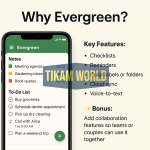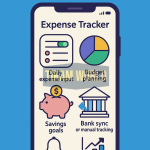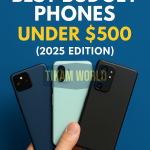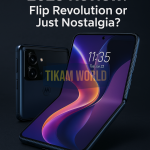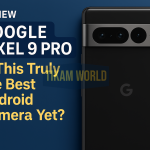iPhone 16 Pro Max vs Galaxy Z Fold 6: Which Flagship Wins in 2025?

Picture this: it’s 2025, and you’re standing at the crossroads of smartphone royalty. On one side, the iPhone 16 Pro Max, Apple’s latest masterpiece, promises power, polish, and perfection. On the other, the Galaxy Z Fold 6, Samsung’s foldable titan, dares to redefine what a phone can be. Both are flagship phones vying for your attention—but which one truly deserves the crown?
In this ultimate showdown, we’ll compare these two heavyweights across design, performance, cameras, battery life, and more. Whether you’re a tech enthusiast, a casual user, or just someone who wants the best bang for their buck, this guide will help you decide. Expect vivid descriptions, a handy comparison table, and answers to your burning questions—all wrapped in an engaging, easy-to-read package. Let’s dive in!
Table of Contents
- Introduction: The Flagship Face-Off
- Design and Build: Beauty Meets Innovation
- Display: Classic vs. Cutting-Edge
- Performance: Speed and Power Unleashed
- Cameras: Capturing the Moment
- Battery Life: Who Lasts Longer?
- Software: iOS vs. Android Showdown
- Unique Features: What Makes Them Special
- Price: Is It Worth the Investment?
- Comparison Table: Specs at a Glance
- FAQs: Your Questions Answered
- Conclusion: The 2025 Winner
Introduction: The Flagship Face-Off
Smartphones in 2025 aren’t just devices—they’re lifestyles. The iPhone 16 Pro Max and Galaxy Z Fold 6 represent the pinnacle of Apple and Samsung’s engineering prowess, each catering to different needs. Apple’s offering is all about refinement: a sleek, powerful phone that fits seamlessly into its ecosystem. Samsung, meanwhile, swings for the fences with a foldable design that transforms from pocket-sized to tablet-like in seconds.
So, what’s the big deal? The iPhone 16 Pro Max is for those who crave reliability, top-tier cameras, and a no-nonsense experience. The Galaxy Z Fold 6, however, is for the bold—those who want to multitask, sketch with an S Pen, or simply flex the future of tech. In this article, we’ll break down every detail to help you pick your 2025 champion. Ready? Let’s get started.
Design and Build: Beauty Meets Innovation
iPhone 16 Pro Max: Timeless Elegance
The iPhone 16 Pro Max is a stunner. With a titanium frame and Ceramic Shield glass, it’s as tough as it is gorgeous. Apple’s design team has shaved down the bezels, giving you more screen in a familiar form factor. It comes in four eye-catching colors: Black Titanium, White Titanium, Natural Titanium, and Desert Titanium. Holding it feels like clutching a piece of the future—solid, premium, and perfectly balanced.
Want to know more about its durability? Check out Apple’s official breakdown here.
Galaxy Z Fold 6: A Foldable Marvel
The Galaxy Z Fold 6 is a different beast. Its foldable design is both futuristic and functional, with a sturdy hinge that unfolds into a tablet-sized screen. Available in Phantom Black, Phantom Silver, and Phantom Green, it’s a head-turner—but it’s not perfect. The crease on the foldable display is still there, and it’s heavier than the iPhone when folded. Still, that hinge feels smoother than ever, and Samsung’s build quality has come a long way.
Curious about the Z Fold 6’s design evolution? Dive into Samsung’s official page here.
Winner: If you love sleek and simple, the iPhone wins. If bold and innovative is your vibe, the Z Fold 6 takes it.
Display: Classic vs. Cutting-Edge
iPhone 16 Pro Max: A Window to Brilliance
The iPhone 16 Pro Max rocks a 6.9-inch Super Retina XDR OLED display with a buttery-smooth 120Hz ProMotion refresh rate. It’s bright—peaking at 2,000 nits—and supports HDR10 and Dolby Vision. Whether you’re binge-watching Netflix or scrolling through Instagram, this screen delivers vibrant colors and deep blacks that make everything pop.
Galaxy Z Fold 6: Double the Fun
The Z Fold 6 offers two screens: a 6.3-inch external display for quick use and a massive 7.6-inch internal foldable Dynamic AMOLED 2X when unfolded. Both run at 120Hz, but the brightness tops out at 1,200 nits—not quite as dazzling as the iPhone. The real magic is in the size: unfold it, and you’ve got a mini tablet for movies, gaming, or running two apps side by side. That crease, though? It’s a minor trade-off for the extra real estate.
Winner: The iPhone’s display is sharper and brighter, but the Z Fold 6’s foldable screen is a multitasking dream.
Performance: Speed and Power Unleashed
iPhone 16 Pro Max: A18 Pro Powerhouse
Apple’s A18 Pro chip, built on a 3nm process, is a speed demon. Paired with 8GB of RAM, it crushes benchmarks and handles everything from 4K video editing to AAA gaming without breaking a sweat. The secret sauce? Apple’s tight hardware-software integration, which makes it feel snappier than the numbers suggest.
Galaxy Z Fold 6: Snapdragon Muscle
The Z Fold 6 runs on the Snapdragon 8 Gen 3, a top-tier Android chip, with 12GB of RAM. It’s no slouch—multitasking across its big screen is a breeze, and it powers through games and apps with ease. Still, in raw performance tests, it lags slightly behind the A18 Pro, especially in single-core tasks.
Winner: The iPhone edges out in raw power, but the Z Fold 6’s extra RAM shines for multitasking.
Cameras: Capturing the Moment
iPhone 16 Pro Max: Photography Perfection
The iPhone 16 Pro Max sports a 48MP main sensor, a 12MP ultrawide, and a 12MP telephoto with 5x optical zoom. Apple’s computational photography is legendary—think crisp details, natural colors, and unbeatable low-light shots. Video is where it really shines, with 4K at 120fps and Dolby Vision support. It’s a filmmaker’s dream.
For a deeper dive into its camera tech, see this review here.
Galaxy Z Fold 6: Versatile Snapper
The Z Fold 6 counters with a 50MP main camera, a 12MP ultrawide, and a 10MP telephoto with 3x zoom. It’s great in daylight, with punchy colors and solid detail, but it doesn’t match the iPhone’s low-light prowess or video quality. Bonus points: the foldable design lets you use the main camera for selfies with the external screen as a viewfinder.
Winner: The iPhone dominates in camera quality, especially for video. The Z Fold 6 is solid but not quite there.
Battery Life: Who Lasts Longer?
iPhone 16 Pro Max: Endurance Champ
With a 4,674mAh battery and the A18 Pro’s efficiency, the iPhone 16 Pro Max lasts all day and then some—up to 27 hours of video playback. Charging is decent at 30W wired and 15W wireless via MagSafe, though it’s not the fastest out there.
Galaxy Z Fold 6: Decent but Draining
The Z Fold 6’s 4,400mAh battery struggles to keep up with its power-hungry foldable screen. You’ll get a day of moderate use, but heavy multitasking might leave you reaching for a charger. It supports 45W fast charging, which is a plus, but overall endurance lags behind.
Winner: The iPhone lasts longer; the Z Fold 6 charges faster.
Software: iOS vs. Android Showdown
iPhone 16 Pro Max: iOS 18 Smoothness
Running iOS 18, the iPhone offers a clean, intuitive experience with Apple Intelligence—think AI-powered photo edits and writing tools. It’s secure, gets years of updates, and plays perfectly with your Mac, iPad, or Apple Watch.
Galaxy Z Fold 6: One UI 6 Flexibility
The Z Fold 6’s One UI 6 (built on Android) is tailored for its foldable form factor. Split-screen multitasking and S Pen support make it a productivity beast. Android’s customization is a perk, but it lacks Apple’s ecosystem polish.
Winner: iOS for simplicity and integration; One UI for flexibility and multitasking.
Unique Features: What Makes Them Special
iPhone 16 Pro Max Highlights
- Apple Intelligence: AI tools for smarter tasks.
- ProMotion: Silky-smooth 120Hz display.
- Action Button: Customizable for quick shortcuts.
Galaxy Z Fold 6 Standouts
- Foldable Display: Tablet-like versatility.
- S Pen: Precision for notes and sketches.
- Dual Screens: External screen for on-the-go use.
Winner: The Z Fold 6’s foldable design is more unique, but the iPhone’s features are more polished.
Price: Is It Worth the Investment?
iPhone 16 Pro Max: Premium but Fair
Starting at $1,199 for 256GB (up to $1,599 for 1TB), the iPhone 16 Pro Max isn’t cheap. But with its build quality, camera, and long-term support, it’s a solid investment.
Galaxy Z Fold 6: Steep but Specialized
At $1,899 for 256GB, the Z Fold 6 is a wallet-buster. You’re paying for the foldable tech, but it’s a niche device—not everyone needs it.
Winner: The iPhone offers better value for most; the Z Fold 6 is for those who crave its unique features.
Comparison Table: Specs at a Glance
| Feature | iPhone 16 Pro Max | Galaxy Z Fold 6 |
|---|---|---|
| Display | 6.9-inch OLED, 120Hz | 7.6-inch foldable OLED, 120Hz |
| Processor | A18 Pro | Snapdragon 8 Gen 3 |
| RAM | 8GB | 12GB |
| Storage | 256GB, 512GB, 1TB | 256GB, 512GB, 1TB |
| Main Camera | 48MP | 50MP |
| Battery | 4,674mAh | 4,400mAh |
| Charging | 30W wired, 15W wireless | 45W wired, 15W wireless |
| Price | Starting at $1,199 | Starting at $1,899 |
FAQs: Your Questions Answered
Which phone has the best camera?
The iPhone 16 Pro Max takes the crown with its superior video recording and low-light performance.
Is the Galaxy Z Fold 6 worth its high price?
If you’ll use the foldable screen for multitasking or creativity, yes. Otherwise, it’s a luxury splurge.
Which has better battery life?
The iPhone 16 Pro Max outlasts the Z Fold 6, especially with heavy use.
Can the Z Fold 6 replace a tablet?
Absolutely—its 7.6-inch unfolded screen is perfect for tablet-like tasks.
Conclusion: The 2025 Winner
So, who wins in 2025? The iPhone 16 Pro Max is the all-around champ for most users—stellar cameras, long battery life, and a refined experience make it a safe bet. But the Galaxy Z Fold 6 steals the show for those who want something different: a foldable phone that doubles as a tablet and oozes innovation.
Your choice depends on you. Love Apple’s ecosystem and top-notch quality? Go iPhone. Crave versatility and a futuristic edge? The Z Fold 6 is calling. Either way, you’re getting a flagship that defines 2025 tech.


